The GeForce GTX 770 Roundup: EVGA, Gigabyte, and MSI Compared
by Ryan Smith on October 4, 2013 9:00 AM ESTPower, Temperature, & Noise
Having seen the gaming performance of these cards and the limited gains from their factory overclocks, let’s move on to power, temperature, and noise. If these cards are going to differentiate themselves it needs to be accomplished by factors the manufacturers have more control over, and their respective coolers are a good way to do it.
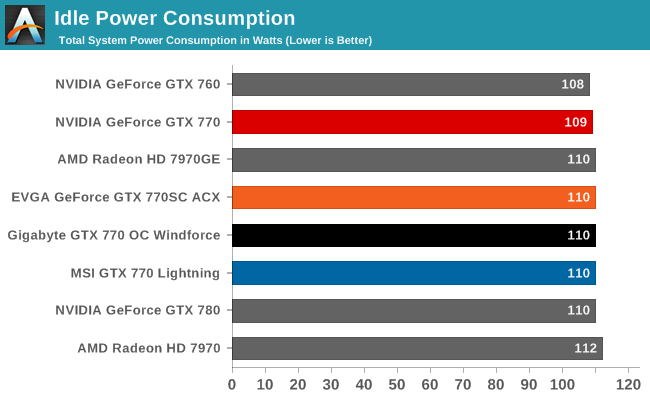
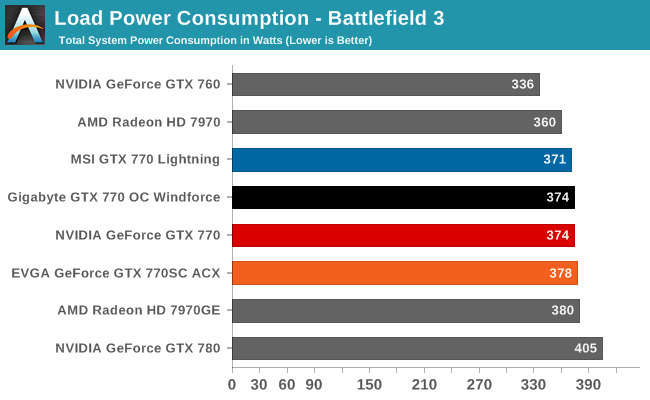
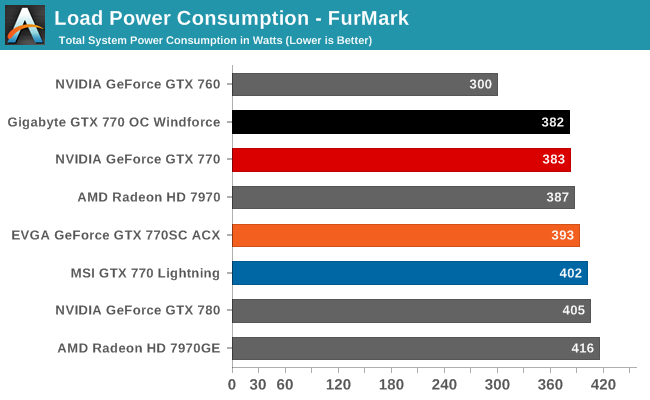
With our cards spanning the full spread of possibilities – semi-custom, custom, and custom with heavily modified power delivery – even load power consumption starts separating the cards to at least a small degree. Although it’s just a minor difference, MSI’s GTX 770 Lightning has the lowest power consumption of the three in Battlefield 3, beating every GTX 770, including the lower clocked stock GTX 770, by at least a few watts. Since we are memory bandwidth limited in BF3, and thereby performance limited, for better or worse these cards can’t get too far from each other. But for a few watts difference we’re in all likelihood looking at general chip-to-chip variation rather than some intrinsic advantage in any one card, even with the use of custom components.
FurMark on the other hand shows some larger differences, but as this is our stress test what we’re really seeing is the difference in the cards’ regulated TDP. MSI’s 260W TDP means they have a larger power budget to work with, draw more power, and don’t get throttled quite as hard as the other cards. The end result being that FurMark is not particularly useful in comparing cards in this case. Otherwise the difference between the EVGA and Gigabyte cards is larger than we’d expect even with chip to chip variation, which may mean Gigabyte’s Ultra Durable component selection has some impact under maximal workloads.
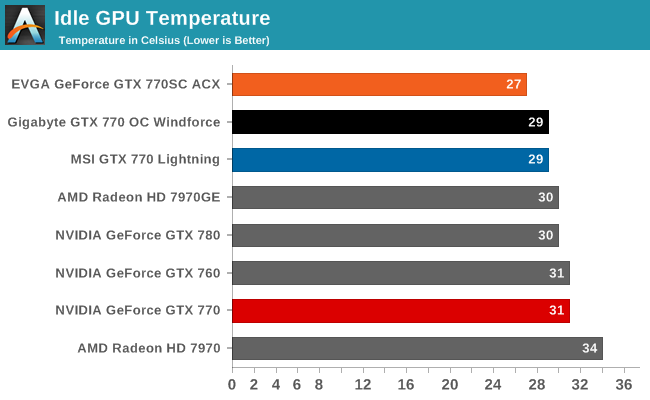
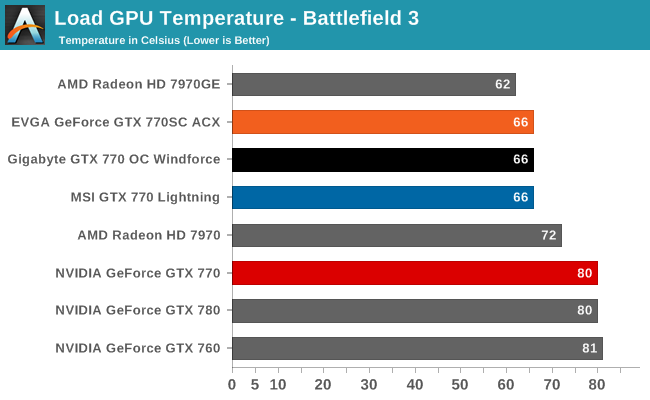
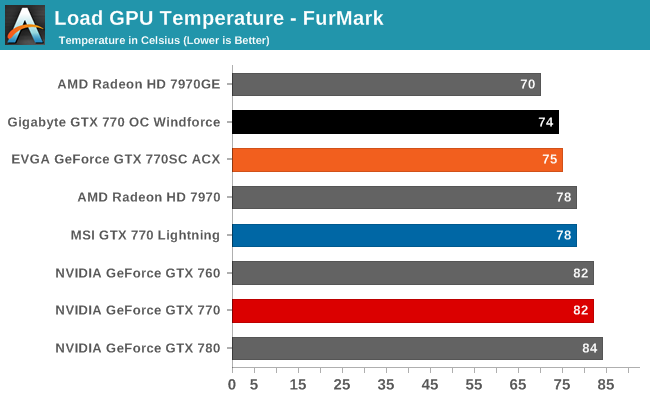
Moving on to temperatures, despite the difference in both the number of fans and the size of said fans, the end result has all of our cards perfectly tied under BF3. Every card tops out at 66C, EVGA, MSI, and Gigabyte alike. Open air coolers as a general design are difficult to improve on, so despite everyone’s efforts, unless someone uses a wildly different fan curve than the others then any well designed open air cooler should perform similar. Notably, because every card tops out at 66C, they’re all well below the thermal throttle point on the GTX 770 of 80C. This means no card ever throttles, which can be useful for squeezing out a little more performance out of what’s otherwise the same GPU.
Meanwhile FurMark temperatures are less than useful here for the same reasons as power. Gigabyte and EVGA top out at 74C and 75C here respectively, while the higher TDP MSI card tops out at 78C. Though this does go to show that even in our stress test none of these cards reaches the 80C throttle point.
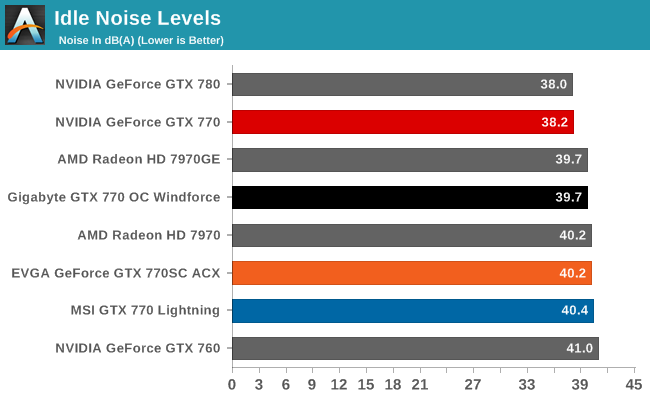
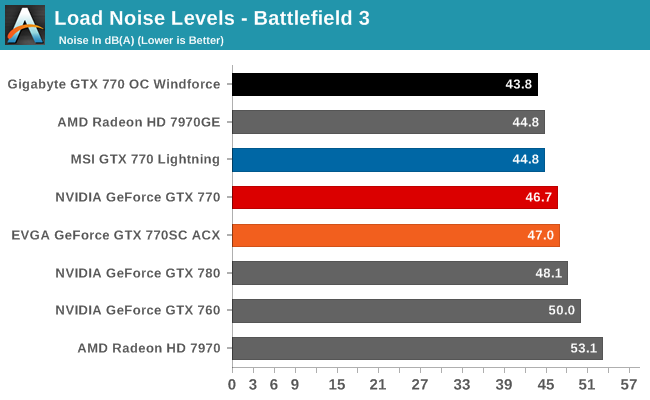

Finally looking at our noise results, we find that unlike our performance data there’s some clear and meaningful separation between the cards, especially between the EVGA card and the remaining two cards. For whatever reason the EVGA card hits 47dB under BF3, a hair louder than even the blower based reference GTX 770. Admittedly the Titan cooler on the reference GTX 770 is overbuilt for a card of this configuration, and as such over performs and is by no means easy to catch, but it does mean that EVGA isn’t gaining anything over the blower from a noise perspective. It’s no worse, it’s just not any better, which indicates that EVGA’s ACX cooler may not be scaling down very well.
MSI and Gigabyte on the other hand manage to beat EVGA and the reference GTX 770 by 2-3dB, a small but not insignificant amount. The winner here is Gigabyte at 43.8dB under BF3, followed by MSI at 44.8dB. These noise levels aren’t going to be silent, but they’re also not too far off of it. For the level of performance these cards offer it’s a fairly impressive outcome, albeit the typical one for the open air cooler tradeoff.
Speaking of silence, when it comes to idle noise every card is actually a bit worse than the reference GTX 770 here, owing to NVIDIA’s single fan and use of materials. The roughly 40dB results aren’t by any means bad, but they aren’t going to get as close to being silent as NVIDIA’s reference blower.
In summary, differences in TDP aside all three cards are solid, similar performers when it comes to temperature and power consumption. However when it comes to noise under load, both Gigabyte and MSI have an edge here over EVGA and the reference GTX 770, which for stock performance does give these cards a small but meaningful lead over the competition. Gigabyte is the best performer in this respect, although MSI is right behind them. At the same time however this means that despite the difference in the designs of their coolers – 3 smaller and 2 larger fans respectively – it isn’t creating a practical difference between the Gigabyte and MSI cards.










55 Comments
View All Comments
dtolios - Friday, October 4, 2013 - link
Downloading evga precision x or msi afterburner is a bit easier than swapping heatsinks me thinks...With this logic reviews should be using only the included drivers, which would dreadfully penalize the card with the older drivers packaged.
In a review that dares to mention "Bios flashing" for a gpu, downloading a universal overclocking utility should be considered as trivial as making sure you have current nvidia or amd drivers.
neaoon - Monday, October 7, 2013 - link
I just want to add my story. I get paid over $87 per hour working online with Google! I work two shifts 2 hours in the day and 2 in the evening. And whats awesome is Im working from home so I get more time with my kids. Its by-far the best job I’ve had. I follow this great link >>>> >>>>neaoon - Monday, October 7, 2013 - link
BAy89com
Elijafire - Saturday, March 22, 2014 - link
Everyone's a critic :p Personally I found the reviews of the software management tools to be useful and informative.vailr - Friday, October 4, 2013 - link
EVGA also has several GTX 7xx cards with dual or even triple bioses.http://www.evga.com/articles/00767/
Would also be interested in further information on whether any video cards being reviewed include a "UEFI GOP video firmware", which Windows 8 would require for installation and running in UEFI mode.
Ryan Smith - Friday, October 4, 2013 - link
Our new testbed (coming soon to a review near you) will be UEFI ready. So we'll finally be able to do some UEFI GOP articles.Gast - Friday, October 4, 2013 - link
"The end result being that MSI has put together a very good card that’s easily competitive with everything else we’ve seen, but without crossing the line into unofficial modifications, the EVGA’s $35 price premium is hard to justify."Shouldn't that be MSI's $35 price premium is hard to justify?
Ryan Smith - Friday, October 4, 2013 - link
Whoops. Yes. Thank you for pointing that out.Elijafire - Saturday, March 22, 2014 - link
You are paying for the highest stock overclock.kwrzesien - Friday, October 4, 2013 - link
Nice review! These are exactly the three cards I was considering, and I think it leaves me leaning in the Gigabyte direction unless I just by the Lightning for the great looks. :)